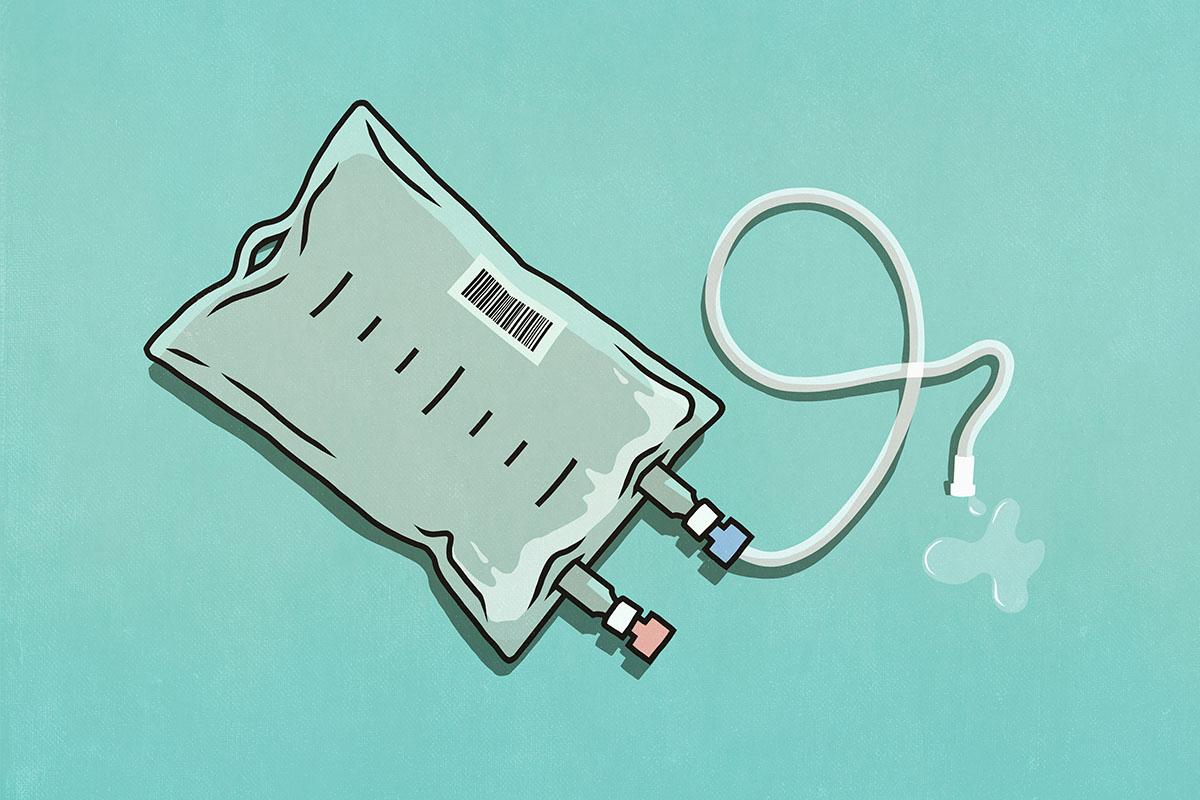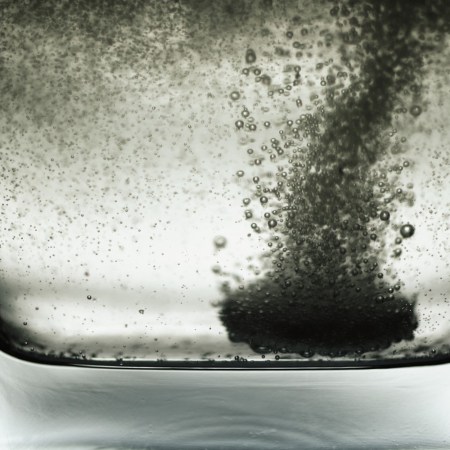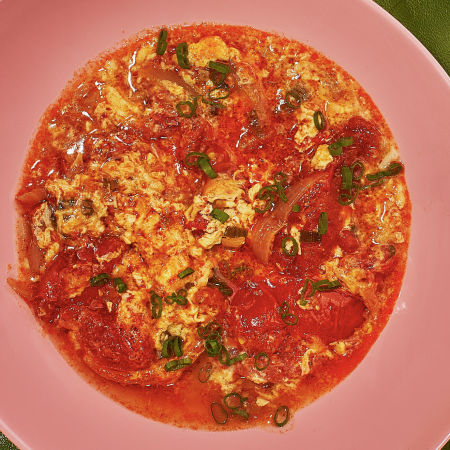I recently caught up with a old acquaintance who’s getting married this fall. He’d had his bachelor’s party the weekend before, and I asked for details. “The usual stuff,” he said. “It was in Austin. We all got IV drips before heading down, had lots of beers and BBQ, one night got a little crazy.”
Typically, I would’ve pressed for more information on the crazy night, but I was confused by how casually he’d referenced “IV drips.” What the hell was he talking about? He chuckled and said it was a “game-changer” his friend group had adopted last year. Before (and often after) a long weekend, they’ll go to a health club or spa, where they’ll hook their arms to intravenous catheters and get pumped full of vitamins and minerals. Pre- or post-sins, the endgame remains the same: extra energy.
Considering that more than 30% of Americans still remain unvaccinated, it may come as somewhat of a surprise that some among us are actively and electively seeking out needles. But IV therapy is indeed having a moment; some 60 years after a Baltimore physician named Dr. John Myers developed Myers’ cocktail — a treatment containing vitamins B6, B12, magnesium, and C, which was designed to help remedy everything from migraines to muscle spasms — there is a crop of brands pitching the work hard-play harder demo on drips as a quick cure-all.
Equinox locations in Hudson Yards, Coral Gables and Orange County now tout an exclusive partnership with NutriDrip, which offers a menu of purpose-tailored infusions with names like The Pre-Game, Mega Recovery and NutrImmunity. There are boutique centers where you can select “B12 shots” as an add-on, while an app named ivee will now send a licensed practitioner (bearing a bespoke bag) right to your door at the time of your choosing. Plus (because of course), celebrities like Kendall Jenner, Hailey Bieber, Rihanna, and even Simon Cowell regularly schedule IV therapy appointments when visiting Miami.
Can IV therapy be trusted, though? Is the science sound? Consider: even the Myers’ cocktail has long come under fire. It was listed on Quackwatch’s index of questionable treatments way back in 2011, and in 2018, US Federal Trade Commission filed a complaint against marketers for “making a range of deceptive and unsupported health claims about their ability to treat serious diseases such as cancer, multiple sclerosis, and congestive heart failure.”
Some diehards, though, were sold after the very first time they tried an IV drip. Bob Wheeler operates two treatment centers in Texas and one in Louisiana. “The vast majority of the claims from IV spas are bullshit…[but] there are a few things you can ‘cure’ with IVs, like hangovers, migraines, and poor performance due to dehydration,” Wheeler says. “We opened our place five years ago because I got an IV for a hangover in Vegas; literally within an hour and a half I was back at a table with a bourbon. I’m in the medical field and as soon as I got out of that chair I knew I had to open one. ”
Wheeler explains that the goal of IV therapy is to bypass the gastrointestinal tract, a route that inherently caps the “bioavailability” of the vitamins. When a vitamin is ingested through the mouth, the body is only able to absorb about half of its nutrients. But when it’s infused straight into the veins, that number soars to 90%.
According to James Gu, spa director at Equinox Hudson Yards, which began offering poolside IV cocktails this Memorial Day, patrons “can expect to feel the effects in a couple of hours…which could include a boost of energy, mental clarity, and a feeling of being well-rested.” That’s an impressive rate of absorption, too, considering it normally takes a much larger chunk of the day to rid toxins and restore hydration.
“Depending on the protocol, IV drips can take from 30 minutes to one hour to administer,” Gu says. “Effects will vary depending on the protocol as well.” That protocol always involves a blend of fluids, electrolytes, nutrients and minerals, but these days, the exact mixture depends on what you’re in the market for, which makes this swell of IV attention different than those in years past — at the same time, it raises even more questions on the legitimacy of the practice.
Are the latest labs behind IV drips really stuffing their bags with the perfect combinations for curing a hangover, or defeating jet lag, or flushing food poisoning? It’s hard to say. They’re certainly not holding back on these newer, personalized options.
For instance, the menu at ivee includes an infusion called “The Athletic Recovery,” which is comprised of saline, Toradol, B-complex, B12, L-Glutathione, magnesium, zinc , L-Carnitine, Tri Amino. That’s a cocktail if there ever was one. While some of the inclusions are to be expected — saline for hydration, magnesium to ease the muscles — Toradol is an anti-inflammatory used to treat pain, and Tri-Amino is a booster typically recruited to facilitate muscle growth and maintenance in horses.
The question here is not necessarily whether IV drips have an impact on the body. You won’t find a health professional that would dispute the significance of proper hydration for recovery, or the impact that certain ingredients, when administered safely, can have on the body. Glutathione, to name the foremost drip-darling, is an antioxidant that detoxifies the liver. After heavy alcohol consumption, it definitely struggles to do its job.
But the disconnect is in thinking that we might as well send in the calvary via catheter. Part of the pitch for The Athletic Recovery reads: “Whether you’re training for a marathon or just starting out at the gym…” Wait, what? Should someone who doesn’t know their kettlebells from their barbells already be lining up to stick a fusion of muscle-building amino acids into his arm? What about stretching, resting and perfecting a protein smoothie?
Where IV therapy leans pseudoscientific — in line with large swarths of the wellness world these days, unfortunately — is in trying to craft a narrative that infusions are essential assets, when in reality, they’re in a murky middle between mildly effective and dangerous. Think about it: if you were so dehydrated that you needed professional assistance, would you go lie down next to a pool at a health club? Wouldn’t you go see a doctor immediately? You know, in a hospital?
The vast majority of IV therapy’s “recovery” drips use the Myers’ cocktail as a base, before mixing in B12 and vitamin C, as if throwing toppings onto an açaí bowl. Micronutrient deficiencies are typical among Americans, but they’re generally tied to dietary decisions. Those who suffer from more severe nutritional deficiencies were likely made aware of such (and started taking a multivitamin) many years before a morning where they woke up extremely hungover or tired from a marathon. The better longterm play is to eat colorfully, and to prioritize plant-based foods, instead of viewing IV therapy as a last-ditch bailout.
IV labs are selling control in the exact situations where we feel like we don’t have any — precisely whenever the body feels miserable. And that control comes at a premium. Most one-off IV treatments start at $250, and depending on the exclusivity of the arrangement, can veer up to a grand. If your last name isn’t Jenner, can you really justify shooting your arm full of saline every time you had a long flight? Can you even justify the expense ahead of special occasions, like, say, a bachelor’s party in Austin?
Believe it or not, there’s some commendable transparency (alongside all the enthusiasm) coming out of IV therapy camps. Dr. Greg Mongeon owns a suite in Minnesota, and while he advocates for frequent use of IV therapy, he acknowledges that when the body takes in an excess of vitamins and minerals, it’ll more or less result in “expensive pee.” He also cautions athletes, as did a number of other IV-associated professionals I spoke to, about taking the cocktails without knowing exactly what’s in the infusion.
“I have treated several professional athletes in my career, and here’s my word of warning — tread lightly! According to USADA and WADA, you’re limited to receiving a 50cc bolus. Most IV bags are either 250, 500, or even 1000cc dosages. If you’re drug-tested, be aware of this! You could lose your ability to compete.”
Down South, Wheeler agrees. “If you’re fully hydrated before an event the IV won’t help you during the competition much. If you aren’t fully hydrated going in, an IV can really save you from that ‘fade’ that occurs midway through…There are things you can add to an IVthat will really help your performance (like Triamino) because they increase your body’s ability to burn fuel and/or move oxygen into your muscles, but you have to be very cautious with some of those. We have a few additives that some governing bodies (PGA, NHL, MMA, et al) consider “performance enhancing” and if you get one of those and get tested, you’re screwed. No athlete should ever get a performance-boosting IV without talking to their sanctioning body first.”
The worst-case scenarios after signing up for IV therapy are hairy: improperly-sanitized needles, kidney failure (if your body has trouble processing calcium), or even a rush of blood that could overwhelm the heart. In the fine print, labs encourage “patients” to have discussed the prospect of IV with their doctors and to know exactly how the body will react to whatever cocktail it receives. But what sort of accountability is there here, when you can order an infusion bag like calling in a fifth of tequila through Drizzly? And what can the FDA do, when IV technically doesn’t administer drugs?
Maybe IV therapy with the guys is just the thing to get you in the mood for a big weekend. And maybe proactively scheduling a session at the end of it will cure your hangover and your Sunday Scaries. But you can’t know that for sure. At present, the scientific evidence for these treatments is small, while the cost is high. Heading into a summer of shenanigans, I recommend sticking to the corner-store hydration cocktail we know all too well: Gatorade, Pedialyte and a whole lotta water.
Whether you’re looking to get into shape, or just get out of a funk, The Charge has got you covered. Sign up for our new wellness newsletter today.
























